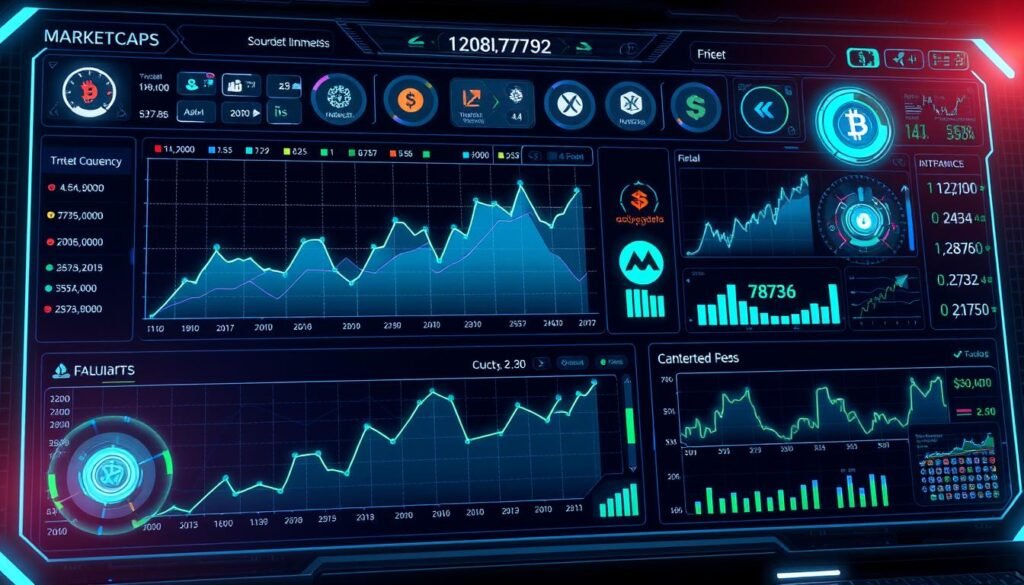Crypto Market Cap Calculator – Are you ready to unlock the secret behind cryptocurrency valuations?
This could change your investment strategy. The world of digital assets is complex, but understanding market capitalization is key.
I’ve spent years learning about crypto market cap calculations.
A crypto market cap calculator is more than a tool. It’s your financial compass in the digital currency world. By using the formula Market Cap = Price per Coin × Circulating Supply, investors can make smart choices.
In this guide, I’ll show you how to use a cryptocurrency portfolio tracker.
This is for both seasoned traders and curious beginners. Knowing about market capitalization will change how you invest in digital assets.
Key Takeaways
- Market cap provides crucial insights into cryptocurrency valuation
- Understand the basic calculation: Price × Circulating Supply
- Different market cap categories represent varying investment risks
- Use crypto market cap calculators for strategic investment decisions
- Track market cap trends to identify potential growth opportunities
Understanding Market Capitalization in Cryptocurrency

Cryptocurrency market capitalization is key for investors to understand digital assets. It shows a cryptocurrency’s value and importance in the market. Let’s explore what makes this concept important.
To find a cryptocurrency’s market cap, you multiply its current price by the coins in circulation. This easy formula helps investors see a digital asset’s total worth.
Basic Components of Market Cap Calculation
The market cap formula uses two main parts:
- Crypto Price: The current price of one token
- Circulating Supply: The total coins available for trading
The Role of Circulating Supply in Market Cap
Circulating supply is the coins in public hands. It doesn’t count coins held by teams or in development wallets. This gives a clearer picture of a cryptocurrency’s real market value.
| Market Cap Category | Total Value Range | Investment Characteristics |
|---|---|---|
| Large-Cap | Over $10 billion | Lower risk, more stable |
| Mid-Cap | $1-$10 billion | Moderate risk, growth potential |
| Small-Cap | Under $1 billion | Higher risk, significant growth potential |
Price Impact on Market Capitalization
“Price volatility directly influences a cryptocurrency’s market capitalization, making it a dynamic and constantly changing metric.”
Price changes can greatly affect a cryptocurrency’s market cap. A quick price jump or drop can change its total value a lot. Investors need to watch prices closely.
How to Use a Crypto Market Cap Calculator for Investment Decisions

Investing in cryptocurrencies needs smart tools like a blockchain investment calculator. I’ll show you how to use these tools to make smart choices.
A decentralized finance portfolio analyzer is key for investors. It helps understand important crypto metrics. Here’s how to use it best:
- Input current cryptocurrency prices
- Check circulating supply data
- Calculate total market capitalization
- Compare different cryptocurrency valuations
When using a blockchain investment calculator, keep these points in mind:
| Market Cap Category | Investment Risk | Potential Growth |
|---|---|---|
| Large-Cap ($10B+) | Low | Stable |
| Mid-Cap ($1B-$10B) | Medium | Moderate |
| Small-Cap (Under $1B) | High | Volatile |
“Understanding market capitalization is like having a financial compass in the crypto landscape.” – Crypto Investment Expert
A decentralized finance portfolio analyzer is more than just numbers. It’s about grasping the whole investment world. Remember, market cap is just one part of evaluating cryptocurrencies.
Pro tip: Always look at market cap, but also do more research. Check out the technology, team, and market trends. This will help you make strong investment choices.
Market Cap Categories: Large, Mid, and Small-Cap Cryptocurrencies
Understanding market capitalization categories is crucial in the crypto world. As an investor, I’ve found these categories give insights into potential and risk.
A good virtual currency capitalization estimator helps make smart choices across different market caps.
- Large-Cap Cryptocurrencies ($10B+)
- Mid-Cap Opportunities ($1B-$10B)
- Small-Cap Potential (Under $1B)
Large-Cap Cryptocurrencies: The Market Leaders
Large-cap cryptocurrencies are the most established digital assets. With market caps over $10 billion, they show strong market confidence.
Bitcoin and Ethereum are examples, offering stable investment chances through my crypto asset management tool.
Mid-Cap Opportunities: Balanced Growth Potential
Mid-cap cryptocurrencies are in a key spot between stability and growth. With market caps from $1 billion to $10 billion, they offer balanced investment chances. Solana and XRP are examples.
| Cryptocurrency | Market Cap | Category |
|---|---|---|
| Bitcoin | $815.45 billion | Large-Cap |
| Ethereum | $260.95 billion | Large-Cap |
| XRP | $32.34 billion | Mid-Cap |
| Stellar (XLM) | $3.5 billion | Mid-Cap |
Small-Cap Potential: High Risk, High Reward
Small-cap cryptocurrencies are new projects with market caps under $1 billion. They have exciting growth potential but also higher risks. Their prices can change a lot, so research is key.
“Understanding market cap categories is key to building a diversified cryptocurrency portfolio.”
When using a virtual currency capitalization estimator, remember market cap is just one factor. Look at technology, team, and market trends too.
The Relationship Between Market Cap and Investment Risk
It’s important to know how market capitalization affects investment risk in the crypto world. A crypto holding value calculator can help investors see the risks in different market cap areas.
Market capitalization plays a big role in the risk of investing in cryptocurrencies. Here’s how market cap relates to investment risk:
- Large-Cap Cryptocurrencies ($10B+)
- Lower volatility
- More stable investment
- Reduced risk potential
- Small-Cap Cryptocurrencies (Under $300M)
- Higher volatility
- Greater growth potential
- Increased investment risk
“Diversification across market cap categories is key to managing cryptocurrency investment risk.” – Crypto Investment Experts
A decentralized digital asset tracker can guide investors through these risk levels. It provides up-to-date market cap information.
The goal is to spread your investments across different market cap segments. This balances risk and potential gains.
| Market Cap Category | Risk Level | Potential Returns |
|---|---|---|
| Large-Cap | Low | Moderate |
| Mid-Cap | Medium | High |
| Small-Cap | High | Very High |
While big market cap cryptocurrencies are more stable, smaller ones offer great growth chances. It’s crucial to know your risk level and investment goals.
Analyzing Fully Diluted Market Cap vs. Current Market Cap
Understanding cryptocurrency valuation is complex. It requires deep insights into market capitalization metrics.
Investors must look beyond simple current valuations. They should explore the potential future landscape of digital assets.
The difference between current market cap and fully diluted market cap (FDV) is crucial. It offers critical perspectives for cryptocurrency portfolio tracker strategies.
Let’s explore the key considerations that impact token valuation and investment decisions.
Impact on Token Valuation
Market capitalization shows the total value of a cryptocurrency. It’s calculated by multiplying circulating tokens by current price.
Fully diluted market cap goes further by including all potential tokens that could be mined or distributed in the future.
- Current Market Cap: Reflects existing circulating tokens
- Fully Diluted Market Cap (FDV): Considers maximum potential token supply
- Significant differences between these metrics signal potential future value changes
Future Supply Considerations
Investors need to think about how future token releases might affect valuations. A higher FDV compared to current market cap could mean potential inflation. This could dilute existing token values.
“Not all market caps are created equal. Understanding the nuanced differences can protect your investment strategy.” – Crypto Investment Analyst
Investment Strategy Implications
When analyzing cryptocurrencies, compare the current market cap to its fully diluted valuation.
A ratio over 10x might suggest risks. Use a comprehensive cryptocurrency portfolio tracker to monitor these metrics and make informed investment decisions.
- Evaluate token release schedules
- Assess potential inflationary impacts
- Consider long-term token economics
Market Cap’s Influence on Cryptocurrency Liquidity
It’s key for crypto investors to grasp the link between market cap and liquidity.
A digital asset valuation tool shows that market cap affects how easily a cryptocurrency can be traded. This, in turn, shapes the market’s dynamics.
Liquidity is about how simple it is to turn crypto into cash without big price swings. Big-cap cryptos usually have better liquidity. This makes them more appealing to investors.
“Liquidity is the lifeblood of cryptocurrency markets, separating stable investments from speculative risks.”
- Large-cap cryptocurrencies have smoother trading experiences
- Small-cap cryptocurrencies face wider bid-ask spreads
- Market cap directly correlates with trading ease
Investors can check liquidity through several important metrics:
| Market Cap Category | Liquidity Level | Trading Characteristics |
|---|---|---|
| Large-Cap ($10B+) | High | Stable, Easy Trading |
| Mid-Cap ($1B-$10B) | Medium | Moderate Volatility |
| Small-Cap (Under $1B) | Low | High Risk, Potential Manipulation |
By using digital asset valuation tools, investors can better understand crypto markets. They learn how market cap affects liquidity and investment risks.
Bitcoin’s Historical Market Cap Analysis: A Case Study
Exploring Bitcoin’s market cap shows a thrilling journey of digital currency growth. It’s key for blockchain investment calculators and decentralized finance portfolio analyzers.
Bitcoin’s path is truly dynamic. Since 2009, it has grown from an experiment to a major financial tool.
Bull Market Patterns
In bull markets, Bitcoin’s value soars. Key traits include:
- Rapid price hikes
- More institutional money
- More interest from global retail investors
“Bitcoin’s market cap is not just a number, but a reflection of global financial sentiment.” – Crypto Analyst
Bear Market Trends
Bear markets show different trends, like:
- Price stabilization
- Lower trading volumes
- Reevaluating cryptocurrency value
| Date | Circulating Bitcoin | Price per Coin | Market Cap |
|---|---|---|---|
| Nov 10, 2021 | 18,866,020 | $69,044.77 | $1.302 billion |
Knowing these patterns helps investors use blockchain tools wisely. This way, they can navigate the unpredictable crypto world better.
Portfolio Management Using Market Cap Metrics
Managing a cryptocurrency portfolio needs a smart plan and careful study. I’ve created a detailed method for using market cap metrics. It helps make better investment choices.
When building a diverse portfolio, it’s wise to look at different market sizes. A tool that estimates virtual currency capitalization helps see risks and possible gains in various crypto areas.
- Large-cap assets provide stability
- Mid-cap cryptocurrencies offer balanced growth potential
- Small-cap investments can generate high returns
My strategy for investing involves checking portfolio metrics to boost performance:
| Metric | Significance | Target Range |
|---|---|---|
| Return on Investment (ROI) | Performance measurement | 10-25% annually |
| Portfolio Volatility | Risk assessment | Moderate (15-30%) |
| Sharpe Ratio | Risk-adjusted returns | Above 1.0 |
“Successful crypto investing is about strategic diversification and continuous monitoring.” – Crypto Investment Experts
By using market cap data and advanced analysis, investors can build strong crypto portfolios. These portfolios balance risk and growth potential well.
Market Cap Manipulation and Price Volatility Factors
The cryptocurrency market is full of challenges for investors. It’s important to understand market cap dynamics and potential manipulation.
My research into crypto market behavior offers key insights. These can help protect your investments with a crypto holding value calculator and decentralized digital asset tracker.
Cryptocurrency markets are easy targets for price manipulation, mainly for smaller coins. Investors need to know the key factors that can greatly change asset values.
Whale Impact on Small-Cap Cryptocurrencies
Large cryptocurrency investors, or “whales,” can greatly affect small-cap coin prices with their trading. Their big holdings let them move markets a lot:
- Sudden large sell-offs can cause prices to drop fast
- Buying strategically can make prices seem higher
- Less liquid markets make manipulation risks higher
Volume-to-Market Cap Ratio Analysis
Looking at the volume-to-market cap ratio gives important insights into market manipulation. I suggest tracking these metrics with a decentralized digital asset tracker.
This helps spot suspicious trading patterns.
| Market Cap Size | Manipulation Risk | Recommended Strategy |
|---|---|---|
| Small-Cap ($10M-$100M) | High | Extensive Research |
| Mid-Cap ($100M-$1B) | Medium | Careful Monitoring |
| Large-Cap (>$1B) | Low | Standard Tracking |
“In the crypto world, knowledge is your best defense against market manipulation.” – Crypto Investment Insights
By using a detailed crypto holding value calculator and staying alert, investors can better handle the complex crypto market.
Advanced Tools for Market Cap Analysis and Tracking
Exploring the world of cryptocurrency needs advanced tools for market cap analysis.
I’ve looked into several top platforms that can change how you use a crypto market cap calculator and a cryptocurrency portfolio tracker.
Top platforms for detailed market analysis include:
- CoinStats: Trusted by over 1 million users
- CoinLedger: Supporting 500,000+ investors
- CryptoCompare: Tracking over 5,000 altcoins
- Delta: Offering portfolio management across cryptocurrencies, stocks, and NFTs
When picking a crypto market cap calculator, look for these important features:
- Real-time price tracking
- Historical data visualization
- Multi-exchange synchronization
- Tax reporting capabilities
Choose platforms that integrate well with other tools. For example, CoinStats syncs easily with many exchanges and wallets. CoinLedger imports data automatically from Coinbase and MetaMask.
| Platform | Users | Key Feature | Price |
|---|---|---|---|
| CoinStats | 1,000,000+ | Free wallet tracking | Free/Premium |
| Delta | 500,000+ | Multi-asset tracking | $59.99/year |
| Kubera | Individual investors | Comprehensive asset tracking | $150/year |
Pro tip: Always check data from different sources to ensure it’s accurate in your cryptocurrency portfolio tracker.
“The right tool can transform complex crypto data into actionable investment insights.”
Using these advanced tools will give you deeper insights into market caps. This will help you make better investment choices in the ever-changing world of cryptocurrency.
Key Factors Affecting Future Market Cap Valuations
The world of cryptocurrency is always changing.
Market value is influenced by many things. Knowing these can help investors make better choices with tools like digital asset valuation tools or altcoin value estimators.
Regulatory Landscape Impacts
Regulations have a big impact on cryptocurrency values. Laws and policies can change how people feel about investing. Important things to consider include:
- Cryptocurrency legal status in different places
- Taxes for trading digital assets
- Rules for blockchain projects
Technology Adoption Rates
How fast blockchain technology grows affects market value. Coins with real-world uses tend to grow more in value.
| Technology Adoption Factor | Potential Market Cap Impact |
|---|---|
| Enterprise Blockchain Integration | High Positive Potential |
| Decentralized Finance (DeFi) Growth | Moderate Positive Impact |
| Institutional Cryptocurrency Investments | Significant Positive Influence |
Market Sentiment Indicators
What investors think can quickly change cryptocurrency values. Social media, community involvement, and world economic conditions are key.
“In the crypto world, sentiment can change market caps faster than traditional financial markets.” – Crypto Analyst
By looking at these factors, investors can use digital asset valuation tools wisely. This helps in making smart choices in the fast-changing crypto market.
Conclusion
My exploration of the cryptocurrency market showed me how vital market capitalization is.
A blockchain investment calculator gives key insights into growth and risks. It helps investors plan their digital asset portfolios better.
The decentralized finance portfolio analyzer is a must-have for crypto fans. It helps balance risks and chances.
Big-cap coins are stable, while small-cap ones might grow fast. My study highlights the need to look at more than just market cap.
Investors need to stay flexible as the crypto world changes.
Using various tools and keeping up with trends is key. Whether you’re into well-known coins or new blockchain projects, understanding market cap is crucial.
Successful crypto investing means always learning and thinking strategically. With advanced tools and a deep market understanding, you can invest with confidence.
This exciting financial frontier is always changing, and being prepared is essential.
FAQ
What is a crypto market cap calculator?
A crypto market cap calculator is a tool that shows the total value of a cryptocurrency. It does this by multiplying the current price by the number of coins in circulation.
This makes it easy to compare the sizes and values of different digital assets.
How do I calculate a cryptocurrency’s market capitalization?
To find the market capitalization, multiply the current price by the total number of coins in circulation. For example, if a coin is worth 0 and there are 1 million coins, its market cap is 0 million.
Why is market cap important in cryptocurrency investing?
Market cap is key because it shows a coin’s size, stability, and growth potential. Big market cap coins are usually more stable. But, smaller coins might grow faster and offer more risk.
What’s the difference between current and fully diluted market cap?
The current market cap uses coins already in circulation. The fully diluted market cap includes all coins, even those not yet mined. This gives a clearer picture of a coin’s total value.
How do market cap categories affect investment strategy?
Coins are grouped by market cap: large-cap (B+), mid-cap (
FAQ
What is a crypto market cap calculator?
A crypto market cap calculator is a tool that shows the total value of a cryptocurrency. It does this by multiplying the current price by the number of coins in circulation.
This makes it easy to compare the sizes and values of different digital assets.
How do I calculate a cryptocurrency’s market capitalization?
To find the market capitalization, multiply the current price by the total number of coins in circulation. For example, if a coin is worth $100 and there are 1 million coins, its market cap is $100 million.
Why is market cap important in cryptocurrency investing?
Market cap is key because it shows a coin’s size, stability, and growth potential. Big market cap coins are usually more stable. But, smaller coins might grow faster and offer more risk.
What’s the difference between current and fully diluted market cap?
The current market cap uses coins already in circulation. The fully diluted market cap includes all coins, even those not yet mined. This gives a clearer picture of a coin’s total value.
How do market cap categories affect investment strategy?
Coins are grouped by market cap: large-cap ($10B+), mid-cap ($1B-$10B), and small-cap (under $1B). Each group has different risks and rewards.
Large-cap coins are stable, mid-cap offer a balance, and small-cap have more risk but higher potential returns.
Can market cap be manipulated?
Yes, market cap can be manipulated, mainly for smaller coins.
Big investors can change prices, and low-liquidity markets are more prone to price inflation. It’s important to check volume-to-market cap ratios and other signs to spot manipulation.
What tools can I use to track cryptocurrency market cap?
Reliable tools for tracking market cap include CoinMarketCap, CoinGecko, and TradingView. These platforms offer real-time data, historical charts, and more to help investors make smart choices.
How does market cap relate to cryptocurrency liquidity?
Coins with larger market caps usually have better liquidity. This means it’s easier to buy and sell without affecting the price much.
Smaller coins have lower liquidity, leading to wider price swings and more volatility.
Should I base my entire investment strategy on market cap?
No, market cap is important but shouldn’t be the only factor. Look at technology, team, adoption, volume, and market sentiment too. This helps you make a well-rounded investment decision.
How often should I check or rebalance my crypto portfolio based on market cap?
Check your portfolio every quarter or when the market changes a lot. Rebalancing helps keep your risk level right and takes advantage of market shifts. But, avoid too much trading to save on fees and taxes.
B-B), and small-cap (under
FAQ
What is a crypto market cap calculator?
A crypto market cap calculator is a tool that shows the total value of a cryptocurrency.
It does this by multiplying the current price by the number of coins in circulation. This makes it easy to compare the sizes and values of different digital assets.
How do I calculate a cryptocurrency’s market capitalization?
To find the market capitalization, multiply the current price by the total number of coins in circulation. For example, if a coin is worth $100 and there are 1 million coins, its market cap is $100 million.
Why is market cap important in cryptocurrency investing?
Market cap is key because it shows a coin’s size, stability, and growth potential. Big market cap coins are usually more stable. But, smaller coins might grow faster and offer more risk.
What’s the difference between current and fully diluted market cap?
The current market cap uses coins already in circulation. The fully diluted market cap includes all coins, even those not yet mined. This gives a clearer picture of a coin’s total value.
How do market cap categories affect investment strategy?
Coins are grouped by market cap: large-cap ($10B+), mid-cap ($1B-$10B), and small-cap (under $1B). Each group has different risks and rewards.
Large-cap coins are stable, mid-cap offer a balance, and small-cap have more risk but higher potential returns.
Can market cap be manipulated?
Yes, market cap can be manipulated, mainly for smaller coins.
Big investors can change prices, and low-liquidity markets are more prone to price inflation. It’s important to check volume-to-market cap ratios and other signs to spot manipulation.
What tools can I use to track cryptocurrency market cap?
Reliable tools for tracking market cap include CoinMarketCap, CoinGecko, and TradingView. These platforms offer real-time data, historical charts, and more to help investors make smart choices.
How does market cap relate to cryptocurrency liquidity?
Coins with larger market caps usually have better liquidity. This means it’s easier to buy and sell without affecting the price much.
Smaller coins have lower liquidity, leading to wider price swings and more volatility.
Should I base my entire investment strategy on market cap?
No, market cap is important but shouldn’t be the only factor. Look at technology, team, adoption, volume, and market sentiment too. This helps you make a well-rounded investment decision.
How often should I check or rebalance my crypto portfolio based on market cap?
Check your portfolio every quarter or when the market changes a lot. Rebalancing helps keep your risk level right and takes advantage of market shifts. But, avoid too much trading to save on fees and taxes.
B). Each group has different risks and rewards. Large-cap coins are stable, mid-cap offer a balance, and small-cap have more risk but higher potential returns.
Can market cap be manipulated?
Yes, market cap can be manipulated, mainly for smaller coins.
Big investors can change prices, and low-liquidity markets are more prone to price inflation. It’s important to check volume-to-market cap ratios and other signs to spot manipulation.
What tools can I use to track cryptocurrency market cap?
Reliable tools for tracking market cap include CoinMarketCap, CoinGecko, and TradingView. These platforms offer real-time data, historical charts, and more to help investors make smart choices.
How does market cap relate to cryptocurrency liquidity?
Coins with larger market caps usually have better liquidity. This means it’s easier to buy and sell without affecting the price much. Smaller coins have lower liquidity, leading to wider price swings and more volatility.
Should I base my entire investment strategy on market cap?
No, market cap is important but shouldn’t be the only factor. Look at technology, team, adoption, volume, and market sentiment too. This helps you make a well-rounded investment decision.
How often should I check or rebalance my crypto portfolio based on market cap?
Check your portfolio every quarter or when the market changes a lot. Rebalancing helps keep your risk level right and takes advantage of market shifts. But, avoid too much trading to save on fees and taxes.




